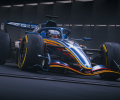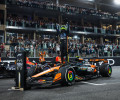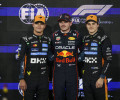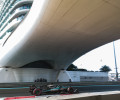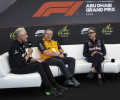FROM AUTO #11: THE THINKER
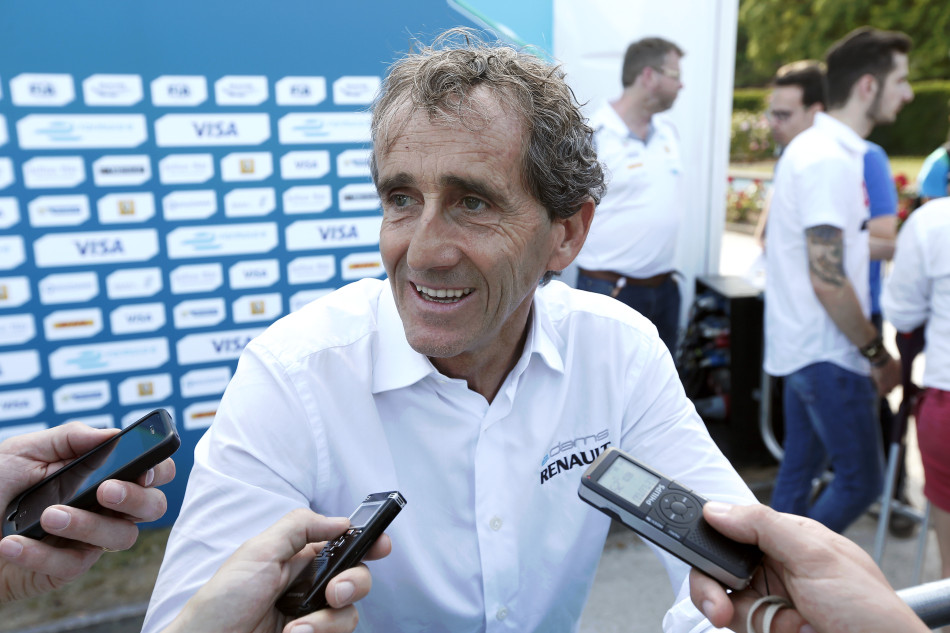
With 12-and-a-half more points, Alain Prost could have been an eight-times Formula One World Champion and indisputably, therefore, the most successful driver to have ever walked the Earth.
As it is, he won four world titles; finished second four times, missing out in 1983, ’84, ’88 and ’90 by the tiniest of margins: two points in ’83, half a point in ’84, then three in ’88 – although he out-scored champion Ayrton Senna before having to shed 18 under that year’s ‘best 11’ rule. In 1990 he was a ‘yawning’ seven points of Senna.
By any measure, Prost’s F1 record is remarkable and he remains, 22 years after retirement, the sport’s second most-winning driver, with 51 grand prix victories to Michael Schumacher’s 91.
Yet for all the weight of achievement, the garlanded 13-season narrative of success, the joint lead role in F1’s most storied rivalry, he remains a hushed legend, a champion spoken about with the greatest respect, but not awe. One whose elegant vitesse would routinely leave rivals floundering, allowing him to vanquish the toughest team-mates (Niki Lauda, Keke Rosberg, Ayrton Senna, Nigel Mansell), yet who rarely excited with feats of derring-do. That simply was not his style.
And he knows it: “People always liked Keke or Ayrton at the time, drivers who expressed their natural talent more in their driving style, rather than with thinking,” he says. “But you can have both. Niki was called ‘the computer’ when he was racing. And why not? People forget that you can also be fast. If you look at the statistics, you see that maybe Ayrton was exceptional in qualifying [65 pole positions] but he was really working on that. I worked more on the race set-up, so it makes a big difference. In race conditions with Ayrton I was never much slower than him. It’s just a different approach.”
METHOD AND MADNESS
As comfortable today in his 60-year-old, bean-lean skin as he was in his racing prime (though still with hungrily chewed nails), Prost is manifestly at ease with his canon, untroubled that his legacy was built on method, not madness. Even if that leaves him perhaps under-rated, under-appreciated and forever ‘the other guy’ in that three-season war with Senna.
He’s wryly amused at the notion that F1 should appreciate him more and you sense that while such ideas may once have troubled him, these days he’s well over it.
“I think I cared a little bit in the past,” he says, those somehow sad grey-green eyes looking momentarily distant, “but now it just sounds funny to me, you know. I am happy at least to be asked the question. You always have this kind of question about who was the best, who was the best driver, the best ever, or whatever... Which is ridiculous, honestly, because you cannot compare. If you have driven in Formula One, especially with different cars, different teams, different ambience, you cannot compare the drivers and number of titles. So in a way maybe I prefer things the way they are now, especially as I’m getting older!”
Prost, still actively involved in motor sport though roles as an ambassador for Renault F1 and as a Formula E team owner, has surely earned the right to a little lofty perspective. He raced, after all, through the still-perilous early ’80s and emerged, a generation later, largely unscathed, unlike compatriot Didier Pironi who was seriously injured at Hockenheim in ’82 or friend Gilles Villeneuve who died at Zolder that same year.
“I was very close with Gilles,” Prost recalls, “and I remember him saying to me – it’s hard to believe, yes – ‘In Formula One you cannot hurt yourself.’ He believed this because he had a lot of huge accidents but never had physical pain.
“But me, in only my third grand prix, at Kyalami, I hit the steering on a kerb and I broke my scaphoid [a wrist bone], and I felt pain. And when you feel the pain, it was like ‘oh, shit, you can hurt yourself in F1’. And I realised that I had to be careful.”
Despite enjoying a justified reputation as one of the cleanest, least incident-prone drivers, Prost recalls a number of big accidents during his 1980 rookie year with McLaren. There were “huge shunts” in testing and practice although none of them resulted in serious injury. “I banged my head a few times though,” he smiles. “In practice at Watkins Glen that year, I had a big one. After that I had almost two weeks at home in bed. No lights… I could not move. I realised then that whenever you lose a front wing or you lose suspension or whatever, you know you really need luck.”
The accidents two seasons later to Villeneuve and especially to Pironi, which happened during a wet German GP qualifying session, once again forced him to reflect on his approach to racing.
Prost, by then racing for Renault having become disillusioned with a pre-Ron Dennis-era McLaren, was the unwitting catalyst for Pironi’s career-ending wreck. Pironi was carrying out tyre evaluation and on a hot lap moved to pass the Williams of Derek Daly. In doing so, he slammed into the back of Prost’s RE30 – invisible in the track-spray – launching his Ferrari 20 feet into the air. Pironi’s car slammed down and somersaulted, leaving him with multiple leg fractures.
“After that day,” says Prost, “I decided in wet conditions, with no visibility, I would do it the way I want. I said to [team boss] Gerard Larrousse, ‘Okay, you want me to continue, you want me to go back in the car very quickly. Give me 15 minutes.’ I was in the motorhome in Hockenheim for 15 minutes alone and I said: ‘Okay, no problem, I think you’re right, but I can tell you from today, I do what I want when it’s wet.’ People did not know that at the time, but I always did what I thought was reasonable.”
LEARNING FROM LAUDA
As with Lauda before him, Prost had concluded that certain levels of risk in racing were unacceptable and that his approach to on-track action would always be tempered by that rationale.
“From the outside, maybe you can’t understand. When it’s very wet, it’s only ‘a big heart,’” [Prost thumps his chest with a first, by way of emphasis] “and sometimes, maybe, it’s easier not to think too much. But it’s not only driving skill. When it’s a bit wet and very slippery, then yes. When it’s very wet it’s something different. You choose either to do it or not. It’s not that you are either the master or the king when it’s very wet. Sometimes it’s only big heart that allows you to stay f at. Both Niki and myself were a bit like this. Why take a big risk when you cannot control it? That’s a big question.”
Prost crystallised this mindset even before he partnered with Lauda to form something of a McLaren ‘superteam’ for 1984. A classic pairing of ‘wily old fox’ with ‘young charger’, together at a McLaren re-imagined by Ron Dennis and tech Svengali John Barnard, they would essay a season of dominance: 12 wins from 16 races, five for Niki, seven for Alain, with the title going Lauda’s way. It would be his third and last and was won by a mere half-point.
Speaking to AUTO last year, Lauda recalled having to re-set his approach to the race weekend, faced with the prodigious speed of his ambitious young French team-mate. “In the beginning I thought, ‘No problem. A Frenchman can’t be better than an Austrian. He will have no chance,’” said Lauda. “But he taught me a lesson, because in qualifying we had this stupid 600 horsepower more and qualifying tyres for one lap and Prost used it much better than I did. I could not catch him on a qualifying lap, so I changed immediately my strategy and said ‘I’m going to work for the race from Friday to Saturday to make sure that my race set-up is better than his.’ And this made me in the end world champion – only because I was thinking how to beat the guy in another way, without just driving quicker.”
Prost studied the master that year and employed a more rounded skill set to take back-to-back titles in 1985-6.
“I learned a lot from Niki’s approach to the race,” he confirms, “particularly his mental condition. In 1984, for example, I thought that I was fighting Nelson Piquet, because most of the time he was on pole or very fast, so I thought my target was Nelson. But I was wrong and I learned a lot from that. For example, it’s better to finish fourth and get points and maybe go on to be world champion.”
The approach would be fundamental to his racing over two McLaren seasons alongside Senna, allowing him to out-fox his combative rival to the ’89 title, having already out-scored him in ’88.
Prost’s rivalry with Senna is probably the most documented in Formula One’s history and we decide, on this occasion, not to dwell on it, preferring instead to talk about their later relationship, which became close.
“Our relationship was really exceptional, you know,” Prost reflects, “especially compared to what we had when I was racing! And I promise you that I am sure relations would be very, very good if Ayrton was still with us. There is no question about that.”
Prost pauses for a moment to remember a peer who came to define his own career so sharply, through the most intense competition, and then continues in a tone of bitter-sweet affection: “It’s funny, maybe one week before the accident [Senna’s fatal crash at the 1994 San Marino Grand Prix] we were talking on the phone and I said to Ayrton, ‘You know, it would be funny one day if I had a team and you could be my driver. And we were laughing about that. We were talking at the time to buy Ligier already. At the start of ’94. That would have been fantastic, definitely very good.”
HAPPIEST RACING MEMORY
A Senna-led Prost Grand Prix team. Imagine the attention that would have attracted. Alas, the events of Imola ’94 prevented it ever coming to pass, although Prost did of course go on to become an F1 team boss, acquiring Ligier early in 1997 and racing that year (and on till the end of 2001) as Prost Grand Prix.
The team never fulfilled its promise, despite a handful of strong results, and Prost, sighing heavily, reveals now that he believes the project was doomed from the start: “Three months after I started the team,” he says, “we had some very good results and we almost won a race. But to my family and close friends I was saying ‘I’m dead’. I knew from the beginning. I knew… I know Formula One too well. I know the country too well. So my biggest mistake… If I made one mistake, it was this. It would have been better not to have done it. I should not have made the decision to do it at the last minute. Two days before I signed the contract I did not want to do it any more. But we had a plan with Peugeot and a contract for five years of free engines with lots of development. Then they came back two days before I signed it and it was only three years and I had to pay for the engine… In the end, I was happy to stop.”
It was an inglorious coda to an otherwise stellar F1 existence, so better, maybe, to recall Prost the driver not Prost the team, and savour a racer who won grands prix with four different teams and titles with two. From all that success, through Renault, McLaren, Ferrari and Williams, which period stands out?
Prost is reluctant to compare teams, preferring instead to talk about his career as “a global picture”, but he can’t stop a smile at the memory of the 1986 Australian Grand Prix, in Adelaide, where he took his second title ahead of the far faster Williams-Hondas of Nelson Piquet and Nigel Mansell, having played a year-long strategic game to perfection. Who can forget the image of Prost leaping of the ground in joy alongside his McLaren MP4-2C after the unlikeliest of victories? “We won not just as a team that day. It was more like a family,” he says.
Even this sublime moment, though, doesn’t represent the peak of Prost’s motor racing happiness. For that, he takes us back to his mid-teens and to mid-France, where an athletically gifted and football-mad kid called Alain Prost was proving to be a star rightwinger for his local club in St Etienne, with dreams of turning pro.
“In a way my biggest memory and something I am even more proud of is the start of my career,” he says. “I was very close to being a professional football player, but one day I went karting with my brother. I wasn’t interested at all. I didn’t want to go! But then it was like a revelation – like seeing a star. And I knew: ‘this thing is for me.’”
Over the next 18 months Prost worked ceaselessly, helping his dad with odd jobs, doing house removals, staying in at night to save cash, until he’d amassed 700 French Francs (around €100) – enough to buy his first go-kart.
“And from there I began,” he says, “just me, without any help from anybody to get in. And that, you know, after all this, is the thing I am very proud about.” A pause, then a final twinkle: “You know I was still playing football for my club when I started in F1? McLaren never knew...”

 Facebook
Facebook Twitter
Twitter